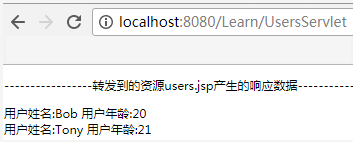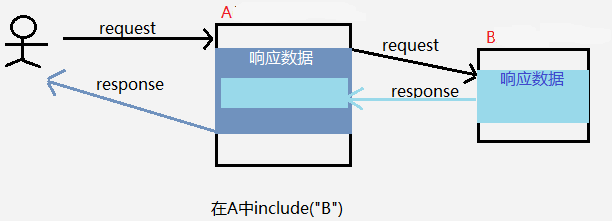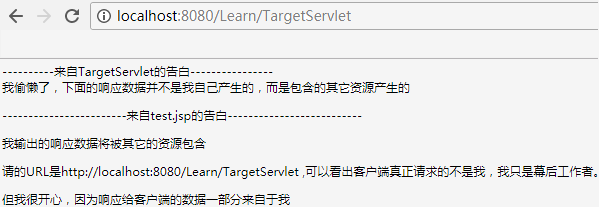requestdispatcher簡(jiǎn)介
requestdispatcher 代表請(qǐng)求的派發(fā)者。它有2個(gè)動(dòng)作:forward 和 include 。客戶端對(duì)于任何一個(gè)請(qǐng)求,可以根據(jù)業(yè)務(wù)邏輯需要,選擇不同的處理辦法:
1、請(qǐng)求的是誰(shuí),誰(shuí)就自己處理并響應(yīng),例如請(qǐng)求的是一個(gè)html,則web瀏覽器顯示的就是這個(gè)html的內(nèi)容。
2、使用requestdispatcher讓其它的資源參與進(jìn)來(lái),協(xié)同完成的響應(yīng),這就是requestdispatcher的主要作用。
requestdispatcher 有一個(gè)特點(diǎn),就是瀏覽器上顯示的url是最先請(qǐng)求的目標(biāo)資源的url,不會(huì)因?yàn)槭褂昧薴orward、include方法而改變。因此forward和include的調(diào)用對(duì)于用戶來(lái)說(shuō)是透明的。
requestdispatcher 實(shí)質(zhì)是一個(gè)接口,有2個(gè)方法分別代表這2個(gè)動(dòng)作。下面一 一介紹。
|
1
2
3
4
5
6
7
8
|
public interface requestdispatcher{ public void forward(servletrequest request, servletresponse response) throws servletexception, ioexception; public void include(servletrequest request, servletresponse response) throws servletexception, ioexception;} |
requestdispatcher.forward(request, response)
這個(gè)方法將請(qǐng)求從一個(gè) servlet or jsp目標(biāo)資源 上 轉(zhuǎn)發(fā)到服務(wù)器上的另一個(gè)資源(servlet、jsp 文件或 html 文件,這些資源必須是當(dāng)前web上下文中的),讓其它的資源去生成響應(yīng)數(shù)據(jù)。
例如用戶請(qǐng)求的是目標(biāo)資源a,a接受到請(qǐng)求后,轉(zhuǎn)發(fā)到b,真正產(chǎn)生響應(yīng)數(shù)據(jù)是被轉(zhuǎn)發(fā)的資源b,而a只是起個(gè)引導(dǎo)轉(zhuǎn)發(fā)作用。瀏覽器的地址欄不會(huì)變,依然是a的url。
這個(gè)方法可以允許被請(qǐng)求的目標(biāo)資源做一些準(zhǔn)備工作后,再讓轉(zhuǎn)發(fā)的資源去響應(yīng)請(qǐng)求。例如下面的例子1。
注意事項(xiàng):
1、在目標(biāo)資源中調(diào)用forward方法時(shí),必須保證此響應(yīng)沒(méi)有提交。也就是不要使用 servletresponse 對(duì)象的輸出流對(duì)象,因?yàn)榧幢隳銓懭肓藬?shù)據(jù)到響應(yīng)緩沖區(qū),最后也會(huì)被清空,如果緩沖區(qū)數(shù)據(jù)被刷新提交(out.flush),還會(huì)拋出illegalstateexception異常。
2、對(duì)于forward方法傳遞的request對(duì)象:雖然我們從調(diào)用上看,好像是將request對(duì)象傳遞給轉(zhuǎn)動(dòng)的資源上去了,但是我發(fā)現(xiàn)目標(biāo)資源使用的request對(duì)象和轉(zhuǎn)發(fā)的資源使用的request對(duì)象不是同一個(gè)request對(duì)象,因?yàn)榉謩e從這2個(gè)request中獲取requesturl,發(fā)現(xiàn)是不一樣的。但是在目標(biāo)資源request提取的paramter 和 attribute ,在轉(zhuǎn)發(fā)后的資源的request對(duì)象中,依然都可以提取到,且是相同的。所以,二者只是在請(qǐng)求路徑相關(guān)的屬性上不同,其它api調(diào)用返回的都是一樣的。
3、在forward語(yǔ)句的前后,都不應(yīng)該有響應(yīng)輸出的語(yǔ)句,應(yīng)該會(huì)被忽略。
例子1:一個(gè)簡(jiǎn)單的 mvc演示。servlet充當(dāng)控制器,轉(zhuǎn)發(fā)到view層的jsp。
user.java
|
1
2
3
4
5
6
7
8
9
10
11
12
13
14
15
16
|
public class user{ private string name; private int age; public string getname(){ return name ; } public void setname( string name ){ this .name = name ; } public int getage() { return age ; } public void setage( int age ){ this .age = age ; }} |
usersservlet.java
|
1
2
3
4
5
6
7
8
9
10
11
12
13
14
15
16
17
18
19
|
public class usersservlet extends httpservlet { private static final long serialversionuid = 1l ;protected void doget (httpservletrequest request, httpservletresponse response) throws servletexception , ioexception { /*****************一般實(shí)際開發(fā)這些用戶數(shù)據(jù)都是從數(shù)據(jù)庫(kù)查出來(lái)的*********/ list <user > users = new arraylist <> (); user u1 = new user () ; u1 .setage ( 20) ; u1 .setname ( "bob") ; user u2 = new user () ; u2 .setage ( 21) ; u2 .setname ( "tony") ; users .add ( u1) ; users .add ( u2) ; /*********************************************/ request .setattribute ( "users", users) ; //對(duì)request 進(jìn)制預(yù)處理準(zhǔn)備工作 request .getrequestdispatcher ( "users.jsp").forward( request , response );//轉(zhuǎn)發(fā)到users.jsp,讓他去具體響應(yīng) } } |
users.jsp
|
1
2
3
4
5
6
7
8
9
10
11
12
13
14
15
16
17
18
19
|
<%@ page contenttype= "text/html; charset=utf-8" pageencoding ="utf-8" trimdirectivewhitespaces= "true" session ="true" %><%@ taglib prefix= "c" uri = "http://java.sun.com/jsp/jstl/core" %><!doctype html>< html><head><meta http-equiv = "content-type" content ="text/html; charset=utf-8"><title> 用戶列表</title></head><body><p> -----------------轉(zhuǎn)發(fā)到的資源users.jsp產(chǎn)生的響應(yīng)數(shù)據(jù)------------------ </p>< c:foreach var ="user" items= " ${users}" >用戶姓名:${user.name} 用戶年齡:${user.age} <br /></ c:foreach></body></html> |

例子2:不使用attribute,使用paramter向轉(zhuǎn)發(fā)的資源傳遞參數(shù)。
雖然request對(duì)象沒(méi)有setparameter方法來(lái)設(shè)置參數(shù),但是我們可以在轉(zhuǎn)發(fā)的url后通過(guò)querystring 的方式添加。jsp中的<jsp:foward>標(biāo)簽下的<jsp:param>標(biāo)簽就是使用的這個(gè)原理。

aimservlet.java
|
1
2
3
4
5
6
7
8
|
public class aimservlet extends httpservlet { private static final long serialversionuid = 1l ; protected void doget( httpservletrequest request , httpservletresponse response) throws servletexception , ioexception { request .getrequestdispatcher ( "foo.jsp?num=1") . forward( request , response ); }} |
foo.jsp
|
1
2
3
4
5
6
7
8
9
10
11
12
13
14
15
16
|
<%@ page contenttype= "text/html; charset=utf-8" pageencoding ="utf-8" trimdirectivewhitespaces= "true" session ="true" %><%@ taglib prefix= "c" uri = "http://java.sun.com/jsp/jstl/core" %><! doctype html><html><head><meta http-equiv = "content-type" content ="text/html; charset=utf-8"><title> 標(biāo)題</title></head><body>通過(guò)forward傳遞過(guò)來(lái)的參num=${param.num}</body></html> |
requestdispatcher.include(request, response)
此方法用于包含響應(yīng)中某個(gè)資源(servlet、jsp 頁(yè)面和 html 文件)的內(nèi)容。
調(diào)用者指定一個(gè)被包含的資源,將這個(gè)包含的資源(jsp,servlet,html)的響應(yīng)數(shù)據(jù)包含到自己的響應(yīng)體中。被包含的數(shù)據(jù)是在服務(wù)器上經(jīng)過(guò)運(yùn)行產(chǎn)生的,因此是動(dòng)態(tài)包含,而不同于jsp中的include指令,它是jsp轉(zhuǎn)譯期的靜態(tài)包含,類似于c語(yǔ)言中的宏一樣。
這個(gè)過(guò)程實(shí)質(zhì)是用一個(gè)相同的request再請(qǐng)求一次被包含的資源,將被包含的資源的響應(yīng)數(shù)據(jù)包含到原本的資源中去,構(gòu)成它的響應(yīng)數(shù)據(jù)的一部分。

注意事項(xiàng):
1、被包含者不能設(shè)置servletresponse的響應(yīng)狀態(tài)和響應(yīng)頭(否則并不會(huì)產(chǎn)生效果),因?yàn)檫@些都是包含者做的事,被包含者只需要產(chǎn)生響應(yīng)數(shù)據(jù)解可以了。
2、不同于 forward中的request的傳遞特性:在被包含的資源中從request中獲取請(qǐng)求路徑相關(guān)的信息,發(fā)現(xiàn)依然是原始請(qǐng)求的路徑,也就是瀏覽器地址欄相關(guān)的路徑,也就是說(shuō)被包含的資源獲得的request對(duì)象的路徑屬性和原始請(qǐng)求資源的路徑一樣(見下面的例子1)。其它的api調(diào)用也是一樣的(attribute 和parameter)。
例子1
targetservlet.java
|
1
2
3
4
5
6
7
8
9
10
11
12
13
14
15
|
public class targetservlet extends httpservlet { private static final long serialversionuid = 1l ; protected void doget( httpservletrequest request , httpservletresponse response) throws servletexception , ioexception { response .setcontenttype ( "text/html;charset=utf-8" ); printwriter out = response .getwriter () ; out .println ( "----------來(lái)自targetservlet的告白----------------<br />" ) ; out .print ( "我偷懶了,下面的響應(yīng)數(shù)據(jù)并不是我自己產(chǎn)生的,而是包含的其它資源產(chǎn)生的<br/>" ) ; request .getrequestdispatcher ( "test.jsp") . include( request , response ); out .flush () ; out .close () ; }} |
test.jsp
|
1
2
3
4
5
6
7
8
|
<%@ page contenttype= "text/html; charset=utf-8" pageencoding = "utf-8" trimdirectivewhitespaces = "true" session = "false"%><p> ------------------------來(lái)自test.jsp的告白-------------------------- </p><p> 我輸出的響應(yīng)數(shù)據(jù)將被其它的資源包含 </p>請(qǐng)的url是 <%= request.getrequesturl().tostring() %> ,可以看出客戶端真正請(qǐng)求的不是我,我只是幕后工作者。<p> 但我很開心,因?yàn)轫憫?yīng)給客戶端的數(shù)據(jù)一部分來(lái)自于我 </p> |

例子2:通過(guò)包含路徑后追加querystring來(lái)向被包含資源傳遞參數(shù),以及通過(guò)request.setattribute傳遞屬性。
同樣, jsp中的<jsp:include>標(biāo)簽下的<jsp:param>標(biāo)簽就是通過(guò)在含路徑后追加querystring達(dá)到的傳遞參數(shù)的效果。

|
1
2
3
4
5
6
7
8
9
10
11
12
13
14
15
16
17
18
|
public class targetservlet extends httpservlet { private static final long serialversionuid = 1l ; protected void doget( httpservletrequest request , httpservletresponse response) throws servletexception , ioexception { response .setcontenttype ( "text/html;charset=utf-8" ); printwriter out = response .getwriter () ; out .println ( "----------來(lái)自targetservlet的告白----------------<br />" ) ; out .print ( "我偷懶了,下面的響應(yīng)數(shù)據(jù)并不是我自己產(chǎn)生的,而是包含的其它資源產(chǎn)生的<br/>" ) ; request .setattribute ( "sharedatt", "i`m shared attribute") ; request .getrequestdispatcher ( "test.jsp?sharedparam=im-shared-parameter" ). include (request , response ) ; out .flush () ; out .close () ; }} |
|
1
2
3
4
5
6
7
8
|
<%@ page contenttype= "text/html; charset=utf-8" pageencoding = "utf-8" trimdirectivewhitespaces = "true" session = "false"%><p> ------------------------來(lái)自test.jsp的告白-------------------------- </p><p> 我輸出的響應(yīng)數(shù)據(jù)將被其它的資源包含 </p><p> 從request中提取共享的屬性attribute : <%= request.getattribute("s haredatt") %><p> 從request中提取共享的參數(shù)parameter : <%= request.getparameter("sharedparam" ) %> |

以上就是本文的全部?jī)?nèi)容,希望對(duì)大家的學(xué)習(xí)有所幫助,也希望大家多多支持服務(wù)器之家。
原文鏈接:https://www.cnblogs.com/lulipro/p/7471987.html











